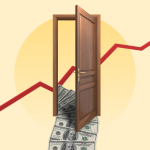Geely-backed EV brand illustrates China’s strategy to dominate the global market as cars go electric and intelligent
A lot is riding on the IPO of ZEEKR, the Chinese EV maker, which started trading Friday on the NYSE under the symbol (NYSE: ZK) after pricing at the top of its range at $41 per share. At a market cap of a little more than $5 billion, this is the first IPO of any real size coming from the People’s Republic of China since the debacle of Didi Chuxing’s (OTC: DIDIY) listing and subsequent delisting in 2021.
Bankers in Hong Kong and Beijing will be staying up overnight on the first day of trading to see if they are likely to get bonuses and still be employed by the end of this year. Institutional investors will seek insight as to whether China is once again becoming investable or remains on the blacklist.
The other U.S.-listed Chinese EV manufacturers will also eagerly watch how Wall Street receives the deal. XPeng (NYSE: XPNG), NIO ((NYSE: NIO), and Li Auto (NASDAQ
NASDAQ
Delving Into ZEEKR’s Prospectus
Given the import of these questions, I combed through the latest ZEEKR prospectus filed with the Securities & Exchange Commission to see what investors could learn. Having recently written about Elon Musk’s strategy to enable Tesla
Tesla
Here are a few things that stood out:
ZEEKR Is Fast Growing But Unprofitable
– ZEEKR’s revenues surged by 62% in 2023 to $7.3 billion, and it earned a positive gross margin of 15% on its EVs, which compares favorably to Tesla’s recently reported gross margin of 17.4% given ZEEKR’s much smaller scale. The company invested nearly $1.2 billion in R&D and booked an operating loss of $1.15 billion for the year, meaning it will likely need additional capital beyond the IPO. Free cash flow was slightly positive for 2023. The company indicated that both revenues and gross margin are expected to decline sequentially in the first quarter of 2024, reflecting softer domestic demand and fierce price competition in China’s domestic EV market.
Global Ambitions
ZEEKR’s majority owner, Geely, appears determined and resourceful about going global as a premium EV manufacturer from China. In addition to ZEEKR, Geely has majority stakes in Volvo (OTC: VLVLY), Polestar (NASDAQ: PSNY), Lotus Cars, and Lynk and Co. All those brands are based in Europe, and Geely has also set up a factory in South Carolina to produce Volvo and Polestar cars for the American market. Geely sold nearly 1.7 million vehicles in 2023, generating $24.8 billion in revenues, and was solidly profitable. ZEEKR’s CEO, Conghui “Andy” An, has said that ZEEKR plans to enter six European countries in 2024, including Germany, Sweden, and the Netherlands, and is targeting another 38 markets across Southeast Asia and the Middle East. Given how far ZEEKR has come since its founding in 2021, underestimating him would be a mistake.
Related Party Riddles
Following the IPO, Geely will continue to own more than half of ZEEKR’s shares, but that’s just the beginning of the related party transactions revealed in the prospectus. CEO An is also the president of Geely Holding Group and Chairman of Geely Holding Group. According to the IPO prospectus, ZEEKR doesn’t manufacture vehicles at factories in Ningbo and Chengdu but relies on “cooperation framework agreements” in which Geely owns the factories and does the heavy lifting. While this helps the company to be more “capital-light,” it also means that Geely has significant input over ZEEKR’s capacity and cost of goods sold. In addition, ZEEKR shares its “sustainable experience architecture” – essentially all the entertainment, mobility, and autonomous driving systems – with other Geely brands. Investors will have to have confidence that Geely will make the best decisions for ZEEKR, which will be actively competing with some of its other brands.
Tech Forward
ZEEKR’s EVs feature impressive technology, but the company is pursuing a much more collaborative strategy than Tesla. Its R&D team is based in Sweden. Its autonomous driving technology comes from Mobileye (NASDAQ: MBLY), and its next-generation EVs will come with embedded DRIVE
iShares S&P 500 Value ETF
NVIDIA
SPDR Dow Jones Industrial Average ETF Trust
Broad Product Range
In China, ZEEKR’s EVs are targeted at the higher-end market, which Tesla has traditionally dominated. Its 001 crossover sells for $41,000, compared to $40,000 for the Tesla Model Y. But it also offers the luxury six-seater ZEEKR 009 van with a range of 500 miles and a 25-minute charge time, a family-friendly option missing from Tesla’s lineup. It also has the Zeekr X compact urban SUV, which sells for about $28,000 in China, filling another popular niche. ZEEKR’s CEO has said that he sees vehicles evolving into a “smart mobility space” where passengers will be able to watch entertainment, work, or even eat a meal while automation takes over the driving.
Future of Global Auto Market is in Play
After looking through ZEEKR’s filings, a few big-picture lessons stand out.
China’s EV market is significantly more advanced and bloodthirsty than the United States or Europe right now—well-funded players like Geely and BYD have a better chance of surviving the looming shakeout.
ZEEKR, while rooted in China, is very sophisticated in its international expansion strategy. For the moment, CEO An has indicated that the United States is off the table as a potential market, except for its robotaxis. However, European automakers ought to be very nervous as higher-end brands come to compete with the likes of VW and BMW. Chinese EV manufacturers will prove very tough competition in Southeast Asia, the Middle East, and Latin America based on their cost advantages and the advanced tech they pack into their cars. The strategy can be summarized as leveraging China’s domestic market to gain scale and drive innovation and then heading overseas to reap the profits of highly efficient production.
Finally, America may want to avoid making EVs a culture war issue and focus on doubling down on innovation, cost-efficient production, and advanced technology. It’s an existential question for American car makers – do they want to be Apple
Apple
Read the full article here
















